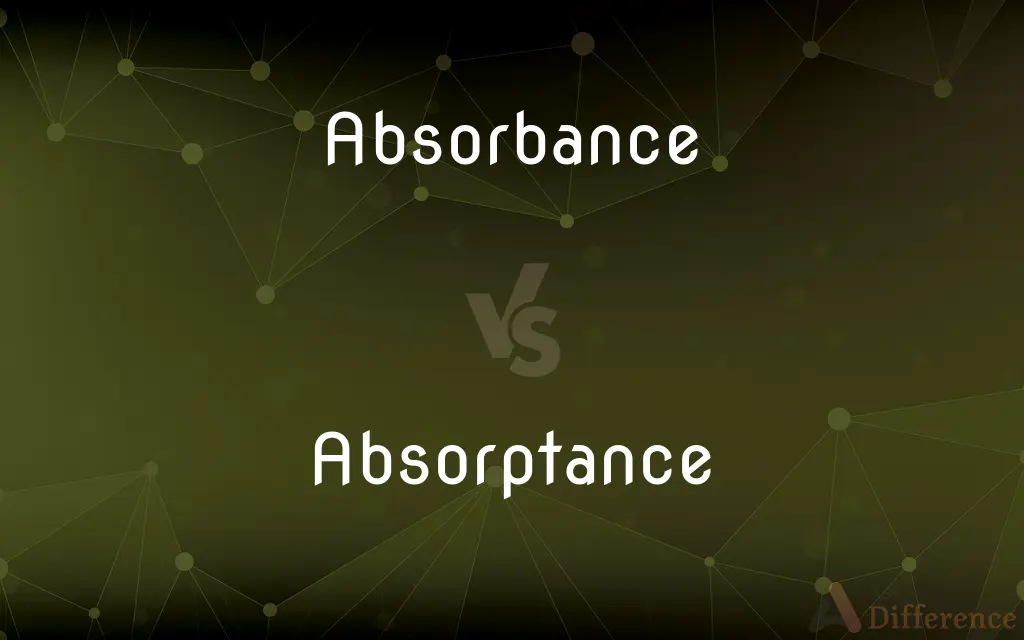Absorbance vs. Absorptance — What's the Difference?
By Tayyaba Rehman — Updated on October 26, 2023
Absorbance measures how much light a material reduces, while absorptance measures the fraction of light a material absorbs.

Difference Between Absorbance and Absorptance
Table of Contents
ADVERTISEMENT
Key Differences
Absorbance quantifies the reduction in light intensity as it passes through a material. Absorptance, on the other hand, refers to the fraction of incident light absorbed by a material.
In spectroscopy, absorbance is a key concept, denoting the logarithmic measure of light attenuation. Contrarily, absorptance is pivotal in thermodynamics, indicating the proportion of absorbed radiation.
Absorbance values do not have units and are used to analyze concentration in solutions. Absorptance values, expressed as a fraction or percentage, are important in solar energy applications.
The Beer-Lambert Law employs absorbance for analytical chemistry, whereas absorptance is crucial for calculating energy balance in heat transfer studies.
Absorbance is determined by path length and concentration, while absorptance depends on material properties and wavelength of the incident light.
ADVERTISEMENT
Comparison Chart
Definition
Logarithmic measure of light reduction
Fraction of incident light absorbed
Application
Spectroscopy, chemistry
Thermodynamics, solar energy
Unit
Dimensionless
Fraction or percentage
Key Law
Beer-Lambert Law
Energy balance in heat transfer
Dependency
Path length, concentration
Material properties, wavelength
Compare with Definitions
Absorbance
Measure of light attenuation in a material.
The absorbance of the solution increased as its concentration rose.
Absorptance
Key factor in calculating energy balance.
The engineer considered the absorptance of different surfaces.
Absorbance
Indicator of how much light a substance absorbs.
With increasing absorbance, the liquid appeared darker.
Absorptance
Proportional value indicating absorbed light.
We calculated the absorptance to evaluate the window’s performance.
Absorbance
Logarithmic ratio of transmitted to incident light.
The spectrophotometer showed a high absorbance for the colored compound.
Absorptance
Fraction of absorbed incident light.
The absorptance of the solar panel determined its efficiency.
Absorbance
Key parameter in Beer-Lambert Law.
To calculate concentration, we used the measured absorbance values.
Absorptance
Ratio of absorbed to incoming radiation.
Materials with high absorptance are preferred in thermal applications.
Absorbance
A unitless value representing light reduction.
The absorbance at 450 nm was crucial for the assay.
Absorptance
Measure of a material’s ability to absorb energy.
The absorptance of the coating affected the building's heat management.
Absorbance
Absorbance is commonly defined as "the logarithm of the ratio of incident to transmitted radiant power through a sample (excluding the effects on cell walls)". Alternatively, for samples which scatter light, absorbance may be defined as "the negative logarithm of one minus absorptance, as measured on a uniform sample".
Absorptance
Absorptance of the surface of a material is its effectiveness in absorbing radiant energy. It is the ratio of the absorbed to the incident radiant power.
Absorbance
(physics) A logarithmic measure of the amount of light that is absorbed when passing through a substance; the capacity of a substance to absorb light of a given wavelength; optical density.
Absorptance
The ratio of the radiation absorbed by a surface to the radiation incident to it.
Absorptance
Absorbed radiation and incident radiation in a ratio format; a measurement that shows how well a surface absorbs radiation.
Absorptance
A measure of the rate of decrease in the intensity of electromagnetic radiation (as light) as it passes through a given substance; the fraction of incident radiant energy absorbed per unit mass or thickness of an absorber;
Absorptance equals 1 minus transmittance
Common Curiosities
What is absorbance?
Absorbance is a logarithmic measure of the reduction of light as it passes through a substance.
Are absorbance and absorptance the same?
No, absorbance measures light reduction, while absorptance measures the fraction absorbed.
What law uses absorbance?
The Beer-Lambert Law in analytical chemistry uses absorbance.
Can absorbance indicate concentration?
Yes, absorbance can be used to determine the concentration of solutions.
Is absorptance important for solar panels?
Yes, absorptance is important in determining the efficiency of solar panels.
Do absorbance and absorptance have units?
Absorbance is dimensionless, whereas absorptance is expressed as a fraction or percentage.
Is absorptance relevant in building materials?
Yes, absorptance is considered in selecting building materials for thermal management.
Does absorbance require a light source?
Yes, absorbance is measured by analyzing the light passing through a material.
What is absorptance?
Absorptance is the fraction of incident light that a material absorbs.
How are absorbance and absorptance used?
Absorbance is used in spectroscopy and chemistry, while absorptance is used in thermodynamics and solar energy.
What property is crucial for absorptance?
The material properties and the wavelength of incident light are crucial for absorptance.
Can absorbance be negative?
No, absorbance is always a positive value or zero.
Can absorptance vary with wavelength?
Yes, absorptance can vary depending on the wavelength of the incident light.
What affects absorbance in a material?
Absorbance is affected by the path length and concentration of the material.
Does absorptance play a role in heat transfer?
Yes, absorptance is vital in calculating energy balance in heat transfer studies.
Share Your Discovery

Previous Comparison
Hospital vs. Hospitality
Next Comparison
Pot vs. VaseAuthor Spotlight
Written by
Tayyaba RehmanTayyaba Rehman is a distinguished writer, currently serving as a primary contributor to askdifference.com. As a researcher in semantics and etymology, Tayyaba's passion for the complexity of languages and their distinctions has found a perfect home on the platform. Tayyaba delves into the intricacies of language, distinguishing between commonly confused words and phrases, thereby providing clarity for readers worldwide.















































